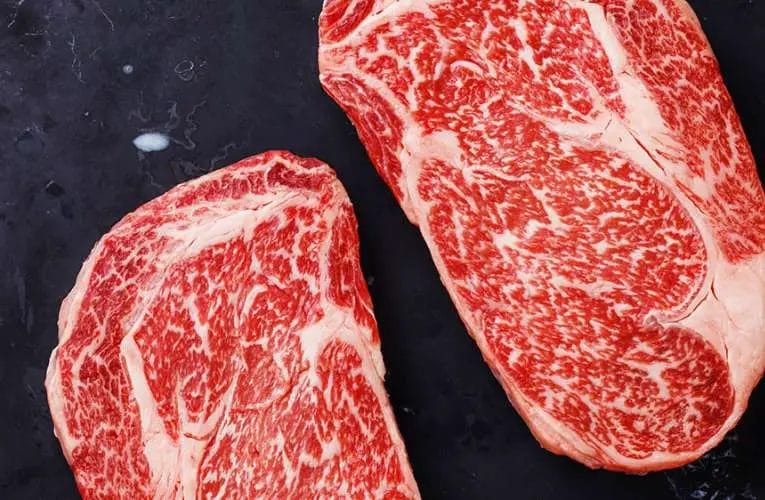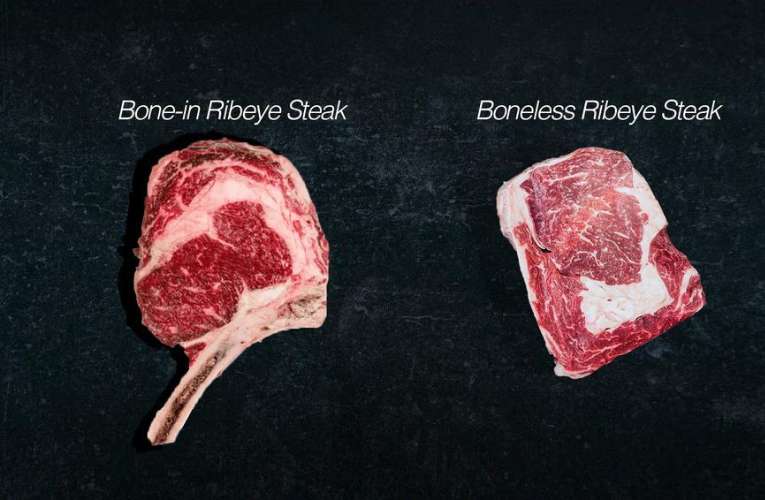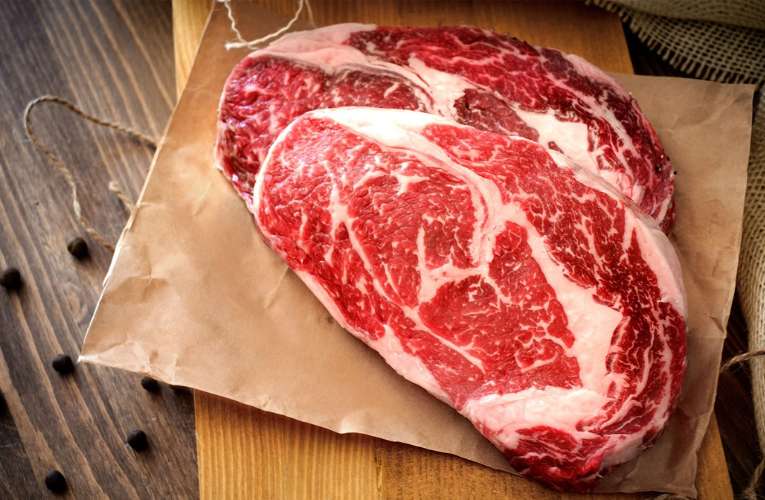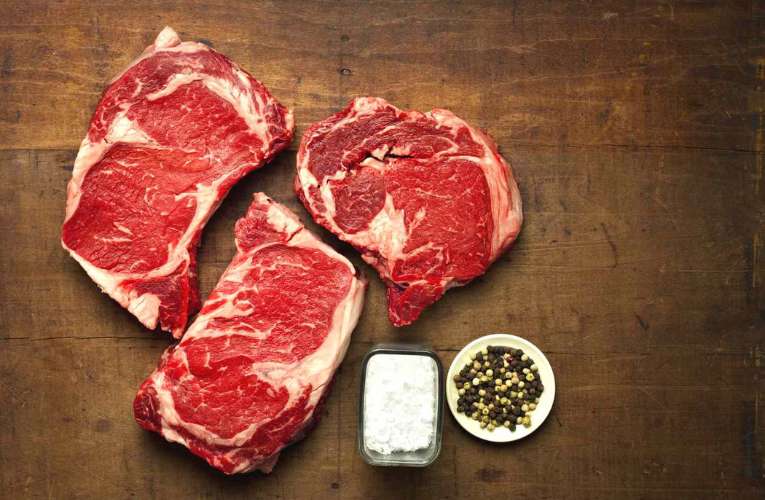When it comes to indulging in a delicious and flavorful steak, few cuts can rival the ribeye. Renowned for its exceptional tenderness and rich marbling, the ribeye steak offers a melt-in-your-mouth experience that meat lovers crave.
However, navigating the world of ribeye steaks can be a daunting task, especially with choices like bone-in and boneless cuts, variations in marbling patterns, and the quest for achieving the ideal level of tenderness and juiciness.
In this article, we will decode the secrets of the perfect ribeye steak, unraveling the differences between bone-in and boneless ribeyes, exploring marbling patterns, and sharing valuable tips for achieving steak perfection.

Exploring Ribeye Steaks
The ribeye steak is a prime cut that is derived from the rib section of beef. This area is known for its tenderness and intense marbling, which contributes to the steak’s rich flavor profile.
The ribeye is cut from the rib primal, which extends from ribs six to twelve in the beef carcass. Its proximity to the rib bones and the surrounding muscles gives it its distinctive characteristics.
Anatomy of the Ribeye Cut
The ribeye cut consists of three main components: the eye, the cap, and the spinalis dorsi. The eye, also known as the “longissimus dorsi,” is the central muscle that runs along the spine.
It is surrounded by a layer of fat called the cap, which adds flavor and juiciness to the steak.
The spinalis dorsi, also known as the “deckle” or “ribeye cap,” is a thin strip of highly marbled meat that wraps around the outer edge of the ribeye, providing an extra burst of flavor.
Why Ribeye is Considered One of the Most Flavorful Cuts of Beef
The ribeye’s exceptional flavor can be attributed to its high fat content and marbling. As the steak cooks, the fat melts and infuses the meat with rich, buttery flavors, resulting in a juicy and succulent bite.
The combination of intramuscular fat and the proper cooking techniques can elevate the ribeye steak to unparalleled heights of flavor.
Bone-in vs. Boneless Ribeyes
Definition and Characteristics of Bone-in Ribeyes
Bone-in ribeye steaks, as the name suggests, include the rib bone within the cut. The bone provides additional flavor and can help retain moisture during the cooking process.
Bone-in ribeyes are often favored by steak enthusiasts who appreciate the primal experience of eating meat directly off the bone.
Advantages and Drawbacks of Cooking Bone-in Ribeyes
Cooking bone-in ribeye steaks presents a unique set of advantages and considerations. The bone acts as a heat conductor, helping to distribute heat more evenly during cooking and resulting in a more consistent steak.
Additionally, the bone-in ribeye tends to have a slightly more robust flavor due to the marrow and connective tissues surrounding the bone. However, the bone can make the cooking process slightly more challenging, as it may require adjustments in cooking time and temperature.
Definition and Characteristics of Boneless Ribeyes
Boneless ribeye steaks are prepared by removing the rib bones from the cut, resulting in a boneless slab of meat.
This allows for easier handling during cooking and slicing. Boneless ribeyes are popular in various culinary applications, from grilling to pan-searing, and are known for their tenderness and ease of preparation.

Advantages and Drawbacks of Cooking Boneless Ribeyes
Cooking boneless ribeye steaks offers certain advantages over their bone-in counterparts. The absence of bones simplifies the cooking process, allowing for more precise control over the steak’s internal temperature.
Boneless ribeyes also tend to cook slightly faster due to the absence of the bone’s insulating effect.
However, without the bone, the steak may lack some of the added flavor and moisture retention that the bone-in version provides.
Understanding Marbling Patterns
Definition of Marbling and Its Significance in Ribeye Steaks
Marbling refers to the intramuscular fat that is distributed throughout the meat, appearing as white streaks or flecks within the muscle fibers.
This marbled fat plays a crucial role in the flavor and texture of ribeye steaks. As the steak cooks, the fat melts, infusing the meat with moisture and delivering a rich, buttery flavor.
The marbling also contributes to the tenderness of the steak, as the melted fat lubricates the muscle fibers, resulting in a more tender bite.
Exploring Different Marbling Grades
Marbling is categorized into different grades based on its quantity and distribution. The most common grading systems include Prime, Choice, and Select.
Prime Grade:
Prime grade ribeyes have the highest level of marbling. These steaks are known for their exceptional tenderness, rich flavor, and luxurious juiciness.
Prime grade ribeyes are often found in high-end restaurants and specialty butcher shops, making them a top choice for steak enthusiasts.
Choice Grade:
Choice grade ribeyes also offer a good amount of marbling, although slightly less than Prime grade.
They are still highly flavorful and tender, making them a popular choice for everyday cooking. Choice grade ribeyes are widely available in supermarkets and offer a great balance between quality and affordability.
Select Grade:
Select grade ribeyes have the least amount of marbling among the three grades. While they may lack the same level of tenderness and richness as Prime or Choice, Select grade ribeyes can still be delicious when cooked properly.
They tend to be leaner, making them a healthier option for those watching their fat intake.
How Marbling Affects Flavor, Tenderness, and Juiciness in Ribeye Steaks
The marbling in ribeye steaks plays a significant role in enhancing the overall eating experience. Here’s how marbling impacts flavor, tenderness, and juiciness:
Flavor: The intramuscular fat in the marbling contributes to the steak’s flavor profile. As the fat melts during cooking, it releases its rich, savory flavors, resulting in a more robust and satisfying taste.
Tenderness: The marbling in ribeye steaks acts as a natural tenderizer. As the fat melts, it bastes the muscle fibers, making them more tender and easier to chew. The higher the marbling, the more tender the steak is likely to be.
Juiciness: The marbling in ribeyes helps retain moisture during cooking. As the fat melts, it mixes with the meat’s natural juices, keeping the steak moist and succulent. This makes for a more enjoyable and satisfying eating experience.
Tips for Selecting Ribeyes with Optimal Marbling Patterns
When selecting ribeye steaks, keep the following tips in mind to ensure you choose cuts with optimal marbling patterns:
Look for visible marbling:
Examine the steak and look for thin streaks of white fat running through the muscle. The more marbling you see, the more flavorful and tender the steak is likely to be.
Consider the grading:
Prime grade ribeyes will offer the highest level of marbling and tenderness. However, if Prime is not available or within your budget, Choice grade ribeyes still provide a good balance of marbling and quality.
Seek well-marbled edges:
Pay attention to the edges of the ribeye, especially the cap and the spinalis dorsi. These areas often have more marbling, contributing to intense flavor and tenderness.
Seek professional advice:
If you’re unsure about selecting ribeye steaks, don’t hesitate to ask your local butcher or meat expert for guidance. They can help you choose the best cuts based on your preferences and cooking methods.
Achieving the Ideal Level of Tenderness and Juiciness
To ensure your ribeye steaks reach the ideal level of tenderness and juiciness, it’s essential to consider various factors and apply appropriate cooking techniques. Here’s what you need to know:
Factors Influencing Tenderness and Juiciness in Ribeye Steaks
Several factors influence the tenderness and juiciness of ribeye steaks, including:
- Aging: Dry aging or wet aging the steak can enhance its tenderness. During the aging process, natural enzymes break down connective tissues, resulting in a more tender texture.
- Thickness: Thicker ribeye steaks tend to retain moisture better and offer a more even cooking experience. Thinner steaks can be prone to overcooking, leading to dryness.
- Cooking temperature: Cooking ribeye steaks to the correct internal temperature is crucial for optimal tenderness and juiciness. Overcooking can result in a dry steak, while undercooking may lead to toughness.
The Role of Aging in Enhancing Tenderness
Aging ribeye steaks allows enzymes to break down connective tissues and promote tenderization. There are two common methods of aging:
Dry Aging:
During dry aging, ribeye cuts are stored in a controlled environment with controlled temperature, humidity, and air circulation. This process can take several weeks and results in intensified flavors, increased tenderness, and a more concentrated beefy taste. Dry-aged ribeyes are often more expensive and can be found in specialty butcher shops or high-end restaurants.
Wet Aging:
Wet aging involves vacuum-sealing ribeye cuts and allowing them to age in their natural juices. This process is typically done in refrigerated conditions for a shorter period, usually a few days to a couple of weeks. Wet-aged ribeyes offer improved tenderness and can be found in most supermarkets or butcher shops.
Recommended Cooking Temperatures for Ribeye Steaks
To achieve optimal tenderness and juiciness, here are the recommended cooking temperatures for ribeye steaks:
- Rare: 120°F to 125°F (49°C to 52°C)
- Medium Rare: 130°F to 135°F (54°C to 57°C)
- Medium: 140°F to 145°F (60°C to 63°C)
- Medium Well: 150°F to 155°F (66°C to 68°C)
- Well Done: 160°F and above (71°C and above)
Keep in mind that personal preferences may vary, and it’s essential to find your ideal level of doneness.

Tips for Cooking the Perfect Ribeye
To ensure you cook the perfect ribeye steak, follow these expert tips and techniques:
Preparing the Ribeye Before Cooking
Bring the steak to room temperature: Allow the ribeye to sit at room temperature for about 30 minutes before cooking. This promotes even cooking and helps prevent the steak from becoming tough.
Pat the steak dry: Use a paper towel to pat the surface of the steak dry. Moisture on the surface can hinder proper searing.
Seasoning Options for Enhancing Flavor
Keep it simple: A classic seasoning of salt and freshly ground black pepper can enhance the natural flavors of the ribeye. Sprinkle both sides of the steak generously before cooking.
Explore additional flavors: Consider experimenting with other seasonings like garlic powder, onion powder, smoked paprika, or herbs like rosemary or thyme to add a unique twist to your ribeye.
Resting and Slicing the Ribeye for Optimal Results
After cooking, allow the ribeye to rest for about 5-10 minutes on a cutting board or a plate. Resting allows the juices to redistribute throughout the meat, resulting in a juicier and more tender steak.
To maximize tenderness, slice the ribeye against the grain. Identify the direction of the muscle fibers and make perpendicular cuts across them. This will result in more tender bites.
Pairing and Serving Ribeye Steaks
To complete the ribeye experience, consider these pairing and serving suggestions:
Suggestions for Complementary Flavors and Side Dishes
Sauces and compound butters: Elevate the flavor of your ribeye with a delicious sauce or compound butter. Classic options include béarnaise sauce, red wine reduction, or a garlic-herb compound butter.
Grilled vegetables: Accompany your ribeye with grilled asparagus, zucchini, or portobello mushrooms. The smoky flavors and charred edges of the vegetables complement the richness of the steak.
Creamy mashed potatoes: Serve the ribeye with creamy mashed potatoes for a comforting and satisfying side dish. The smooth texture of the potatoes pairs well with the tender ribeye.
Conclusion
Decoding the perfect ribeye steak involves understanding the differences between bone-in and boneless cuts, recognizing the importance of marbling patterns, and employing techniques to achieve ideal tenderness and juiciness.
By selecting the right cut, seasoning it well, employing appropriate cooking methods, and allowing the steak to rest properly, you can savor the delectable flavors of a perfectly cooked ribeye.
Don’t be afraid to experiment with different seasonings and cooking styles to find your personal preference.
With these insights and tips, you’re ready to embark on a culinary journey that will delight your taste buds and satisfy your steak cravings. Enjoy the art of cooking and indulging in the world of ribeye steaks!
What is the difference between a ribeye steak and a rib steak?
The main difference between a ribeye steak and a rib steak lies in the way they are cut. A ribeye steak is cut from the rib primal and typically includes the ribeye muscle, cap, and spinalis dorsi, resulting in a highly marbled and flavorful steak.
On the other hand, a rib steak is a larger cut that includes the rib bone along with the surrounding meat, but it may not necessarily include the same level of marbling as a ribeye.
Can I cook a bone-in ribeye steak the same way as a boneless ribeye?
While you can cook both bone-in and boneless ribeye steaks using similar methods, it’s important to consider that bone-in steaks may require slight adjustments in cooking time.
The bone acts as a heat conductor, so bone-in ribeyes may take slightly longer to cook than boneless ones.
It’s recommended to use a meat thermometer to monitor the internal temperature and ensure your steak reaches the desired level of doneness.
Does the grade of the ribeye affect its flavor?
Yes, the grade of the ribeye can significantly impact its flavor. Higher-grade ribeyes, such as Prime grade, tend to have more marbling, resulting in a richer and more flavorful steak.
Choice grade ribeyes also offer good marbling and flavor, while Select grade ribeyes have less marbling and may be leaner. It’s worth noting that personal preferences can vary, and some individuals may enjoy the flavor of a leaner steak.
How can I tell if a ribeye has optimal marbling before purchasing it?
To determine the marbling of a ribeye steak, examine the meat’s appearance. Look for thin streaks or specks of white fat running throughout the muscle fibers. The more marbling you see, the more flavorful and tender the steak is likely to be.
Additionally, choosing higher-grade ribeyes, such as Prime or Choice, can ensure a good level of marbling.
Can I achieve a tender and juicy ribeye steak without aging it?
While aging can enhance the tenderness of a ribeye steak, it is not the only factor that contributes to a tender and juicy result.
Proper cooking techniques, such as searing the steak to lock in juices and cooking it to the appropriate internal temperature, can also yield tender and juicy results.
It’s important to select a well-marbled ribeye and handle it correctly during cooking to maximize tenderness and juiciness.
How long should I rest a cooked ribeye steak before serving?
Allow your cooked ribeye steak to rest for about 5 to 10 minutes before slicing and serving. Resting allows the juices to redistribute within the meat, resulting in a more flavorful and juicy steak. Cover the steak loosely with foil during the resting period to help retain warmth.
Is it necessary to slice a ribeye against the grain?
Yes, it is recommended to slice a ribeye steak against the grain for maximum tenderness. The grain refers to the direction of the muscle fibers within the meat. By slicing across the grain, you shorten the length of the muscle fibers, making the steak easier to chew and more tender.
Can I freeze ribeye steaks?
Yes, you can freeze ribeye steaks. To ensure quality, wrap the steaks tightly in plastic wrap or aluminum foil and place them in airtight freezer bags.
Frozen ribeyes can be stored for several months. When ready to use, thaw the steaks in the refrigerator overnight before cooking. Avoid thawing at room temperature to prevent the growth of harmful bacteria.

